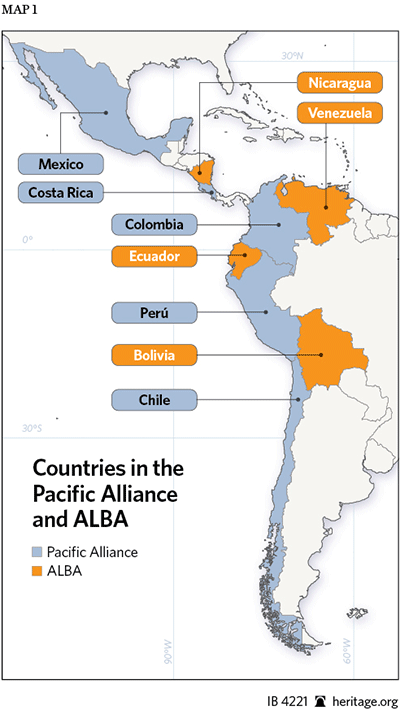This Issue Brief is also available in Spanish at Libertad.org.
In Latin America and the Caribbean, the old 20th-century debate about whether to engage with the global capitalist system is long over, replaced by a virtual consensus about the importance of trade and international investment. A new cleavage has emerged, however, over how to engage the rising economies of Asia. Located mostly on the eastern slopes of the Andes, a group of states including the “Bolivarian Alliance” (ALBA) regimes—Venezuela, Bolivia, Nicaragua, and Ecuador—(plus Peronist Argentina)—have adopted a state-centric model to exploit, inter alia, the loans and investments that frequently accompany increased trade with statist countries such as China.
On the western side of the continent, however, is the Pacific Alliance (PA)—Chile, Colombia, Costa Rica, Mexico, and Peru, and possibly Panama—whose members take a market-led approach, with the state focused on enhancing transparency and efficiency in the flows of capital, goods, and ideas and maximizing investor confidence in the rule of law, the enforcement of contracts, and the protection of intellectual and real property. The long-term benefits reflected by the willingness to follow these policies are obvious with one glance at their respective levels of economic freedom.


By the Numbers: The Pacific Alliance Wins the Debate
As Chart 2 illustrates, the difference is clear. The PA countries, which enjoy per-capita incomes that are well above both ALBA and China,[1] are also far ahead of ALBA with regard to attracting the foreign direct investment—as a percentage of gross domestic product (GDP)—that results in more economic growth and job creation.

The same holds true when it comes to metrics of non-commodity economic growth. The challenge for all South American countries is to wean themselves from dependence on exports of basic agricultural and mineral commodities and other raw materials (i.e., the “Resource Curse”) by adopting economic and other public policies that stimulate the growth of their services and value-added manufacturing sectors without resorting to the protectionism of past decades (e.g., the “import substitution” policies of the 1950s and 1960s). Chart 3 shows that the Pacific Alliance countries are out in front of ALBA in this area as well.

A Latin American economy dominated by crony corporatism and politically populist governments would erode the values that have undergirded Western prosperity and obstruct the optimum economic development of the region. Opportunities for governmental and private-sector corruption and mismanagement would expand in proportion to increased state-to-state megadeals. In fact, they are already happening. According to Latin American market intelligence analyst John Price, “China is the largest source of soft loans to South American governments.… [This is] a long-term strategy to guarantee Chinese companies access to cheap input commodities.”[2]
What to Do
It is in the vital interest of the U.S. and Latin America that all nations in the Western hemisphere be defined by the principles of free markets, free trade, and rule of law. These are the core principles celebrated in the Index of Economic Freedom, published annually by The Heritage Foundation and The Wall Street Journal.[3]
Ironically, it is now PA members that are taking the lead on economic freedom. Meanwhile, the United States has registered steady declines in its economic freedom scores, primarily due to deteriorations in property rights, fiscal freedom, and business freedom. Substantial expansion in the size and scope of government, including through new and costly regulations in areas such as finance and health care, has contributed significantly to the erosion of U.S. economic freedom. The growth of government has been accompanied by increasing cronyism that has undermined the rule of law and perceptions of fairness.
U.S. Can Help Latin America
The U.S. government should not only support initiatives such as the PA but implement similar reforms at home. It should also pursue a truly free-trade-oriented Trans-Pacific Partnership and bilateral and multilateral agreements that strengthen principles of economic freedom and the rule of law.
Through the U.S. Department of State and the Millennium Challenge Corporation, the U.S. government can do more to strengthen the institutional capabilities of its Latin American partners through increased technical assistance to negotiate trade agreements, bolster technical and administrative customs capabilities, combat money laundering and other financial crimes, protect intellectual property, and better enforce commercial laws.
The U.S. argument should expose the false promises of populist elites (e.g., in ALBA countries) who sign deals that are disadvantageous to their countries in return for short-term benefits that allow them to pay off core support groups. The U.S. should not shy away from working with a community of willing nations to restrict access to markets and international lending for regimes that consistently refuse to play by the rules. It should also be careful to show that it is fighting for the well-being of the hemisphere, not simply protecting narrow U.S. corporate interests.
Lead by Example
The U.S. has failed for many years to enunciate clearly to the rest of the hemisphere the principles for which its stands. It has also failed to exert American leadership and to display a disposition to genuine partnership with allies in the region. As Latin America continues to refine the definition of the regime that prevails in the new economy of the Pacific—very much still a work in progress—the stakes have seldom been higher and the need to act seldom more urgent.
—James M. Roberts is Research Fellow for Economic Freedom and Growth in the Center for International Trade and Economics (CITE) at The Heritage Foundation. Tori Whiting and Mo Fan, members of the Young Leaders Program at The Heritage Foundation, made valuable contributions to this report.

